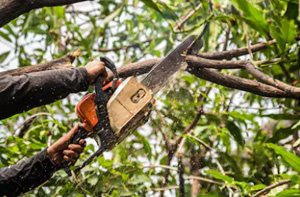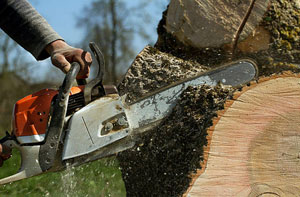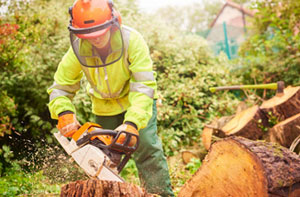Castlereagh Tree Surgeon Northern Ireland: Adding substance, style and structure to what can frequently be a two dimensional area, trees are a crucial feature of gardens and properties in Castlereagh. This is fine and dandy, but when trees are diseased, neglected, or affected by extreme weather events like high winds or flooding, problems can arise which need to be sorted. If you need to have work undertaken on your trees, it is the safest option to consult an experienced tree surgeon in Castlereagh, for their expert advice before any work begins.
Those who use an unqualified operative, or attempt to do tree work themselves, may risk damaging trees, property or even life. However, tree work is not even safe for specialist tree surgeons, who know about all the risks involved. Within the profession there are a worrying average of a hundred and forty serious injuries and three deaths a year, making tree surgery one of the most hazardous jobs in Britain.

There is also a threat to life from poorly maintained or damaged trees in Castlereagh, as around five people annually are fatally wounded in the United Kingdom by falling branches and trees. You may be liable to third-party compensation claims due to the consequences of your actions, if you employ somebody to do tree work and an injury occurs, or property is damaged. This is why it is vitally important to use a skilled tree surgeon to undertake the work on your trees. (Figures sourced from HSE).
There are two principal industry bodies, at least one of which a competent tree surgeon in Castlereagh should be a signed up member of. The websites of either the AA (Arboricultural Association) or the ISA (International Society of Arboriculture) allow you to check out the professional status and membership of any tree surgeon in Castlereagh. To find out if any particular tree surgeon has recognised Approved ARB Contractor status and has membership of either of these organisations, you can check out this page.
If there is a problem during or after any tree work has been concluded you will be able to get in touch with these trade bodies for arbitration assistance and for help and advice at any stage.

You should graciously decline the offer of a quote from anybody who you are unable to find on this directory list, and carry on your search for an approved and qualified tree surgeon. As soon as you've reassured yourself of their accreditations and professional associations you should try and get at least three quotations from different companies in and around Castlereagh. There are various crucial questions that you need to ask whilst you are getting the quotes, and due to the risks of the work involved, you must tell them that you need the answers. You should for instance ask:
- Would I be able to to contact somebody you've recently done work for, so that I can check your work? Independently checking any recent work is always a good idea.
- Can you provide documentary verification of your professional membership, qualifications and a NPTC certificate for the use of a chainsaw? The NPTC/LANTRA is a required certificate in law for any tree worker using a chainsaw. Qualifications can include City and Guilds Certificates and National Diplomas in Arboriculture.
- Exactly what is your level of insurance cover? You should not consider a tree surgeon in Castlereagh with less than £5 Million public liability insurance as outlined by the ISA and AA.
- Can you give me a written quotation? Only ever accept a quote in writing. NEVER take a verbal quote alone.
Clear and accurate details about all the work that is being undertaken should be included on the written quote. Who's responsible for the removal of tree branches, stumps and debris should be stated, as should details about any trees which might be protected in law, and the required steps to get permission to work on them. You should also make sure VAT is included on the quotation. You've got a responsibility for hiring only qualified people to work on your property and trees, and it is important to understand that fact. This is stated under the "Common law duty of care responsibilities and sometimes liabilities under the Occupier's Liability Acts of 1957 and 1984."
PRIOR TO WORK COMMENCING - Making enquiries into the possibility of any of your trees having protected status, your selected Castlereagh tree surgeon should ensure that any work can get the go-ahead from the relevant local authorities. To ensure the safety of the public, even protected trees require maintenance in order to cut back old or damaged wood, therefore discovering that a tree is protected doesn't mean that you're unable to carry out essential work.
If your property in Castlereagh is located in a designated conservation area then a minimum of six weeks written notice is required to the Local Planning Authority before any tree work can be undertaken. This notice is not required if the stem of the tree is less than seventy five millimetres in diameter when measured at 1.5m above ground level. If the branches of a protected tree need to be pruned or thinned to sustain and encourage growth, it is also not necessary to supply notice.

After assessing the health of the trees on your property, your chosen Castlereagh tree surgeon will determine the necessary treatments and how the required outcome can safely be achieved. This will include a full risk assessment of any areas that could be impacted by falling branches and debris, such as in public areas, on your property, and on the properties of neighbours. This stage will also establish the amount of workforce needed and the level of protection required. This could include a number of safety precautions together with personal protective equipment (PPE) to ensure the safety of the general public and nearby property.
ON THE DAY OF WORK - Cones, barriers and safety measures should be put in place before any climbing, tree felling or cutting of branches commences, to keep passers-by and unauthorised persons away from the area where work is going on. Traffic might need to be stopped temporarily if there is a danger of debris falling onto a public highway.
Subject to the type of work that is required a tree surgeon will need varying degrees of protection. When carrying out basic work with a chainsaw, to prevent cutting injuries to the legs, torso and hands, they will at the very least be wearing protective clothing. Eye and head protection, and high-vis clothing, should be worn by all operatives involved in the work.
Ladders and associated climbing equipment will be necessary if working at height is involved, and to help in the removal of high branches and heavy sections of tree trunk, extra personnel will be needed. It's a good idea to inform your next door neighbours of the need for access, because a skip or other method of transporting the waste away will be parked as close as possible to the work area.
UPON COMPLETION OF WORK - All of the waste will be transported away and the area cleared of all debris, once all of the tree work has been completed. Your tree surgeon should then sign off and provide you with a certificate of work done, particularly where the trees are under a protection order. If any public spaces required safety measures, this can be removed and highways and paths will be re-opened.
Issues or problems should be fixed immediately by approaching the tree surgeon directly. If there is any further dispute or arbitration required, and your tree surgeon is a registered member of a professional body, you can get help and advice from the ISA or AA in order to arrive at a satisfactory conclusion.
Locally based Castlereagh tree surgery services are likely to have the telephone code 028 and the postcode BT6. They will operate in Castlereagh itself, along with nearby areas such as Ballgowan, Finaghy, Ormeau, Dundonald, Lisburn, Saintfield, Crossnacreevy, Drumbo, Andersontown, Carryduff, Newtownards, Belfast, Moneyreagh, Comber, Dunmurry, Hannahstown, and these postcodes: BT16 0NN, BT16 0JT, BT16 0NW, BT16 0BY, BT16 0ES, BT16 0BN, BT16 0LU, BT16 0EA, BT16 0HR, BT16 0JN.
If you require this kind of assistance it is unquestionably a good idea to bring in a competent local tree surgeon. Castlereagh householders can benefit from the skill sets that a fully trained professional can offer.
Firewood and Logs Castlereagh

Tree surgeons can be an excellent source for logs or firewood in Castlereagh, if you're searching for this commodity. As felling trees and chopping off branches is part of their daily schedule, this is a natural offshoot for the enterprising tree surgeon.
If you are lucky, you may find a tree surgeon in Castlereagh who gives branches and logs away free to collectors, these will usually be "green" and in need of drying out. Others will sell off their logs by the tonne or in bags, and these will usually be fully seasoned and dried logs, that are ready for burning.
The best logs for burning on your log burner or open fire will be those that have a moisture content of below 20%, and will have been left to dry out for at least twelve months. Most often tree surgeons in Castlereagh will have stocks of assorted hardwood logs, and the good thing about these is that they give a sustained burn, providing three or four hours of comforting heat. If you are also able to lay your hands on some softwood logs, these are terrific for getting a fire started, and upon which you can toss your dry hardwood logs once the fire is blazing.
Tree Surveys Castlereagh
Tree surveys could be needed for various reasons, but most often when property extension or development is concerned. If you happen to be clearing a piece of land to make space for a new house or an extension to an existing property in Castlereagh, for example, you may need to conduct a professional tree survey to British Standards BS5837 if there are trees upon that land. Tree surveys on both private and public property in Castlereagh, must be performed by a qualified tree surveyor or tree surgeon.
If a tree survey is conducted correctly, it will generate a good deal of information about all the trees within the area specified. For instance:
- The age of the trees.
- The spread of branches to East, North, West and South.
- The existence of any Tree Preservation Orders (TPOs).
- The diameter of each tree (taken 1.5m above the ground).
- The number of trees.
- The physiological and structural health of the trees.
- The predicted lifespan of the trees.
- The height of each tree.
- The allocation of a tree reference number for each of the trees.
- The species of trees on the site.
- Recommendations for tree management.
If you're altering an existing property in Castlereagh but are not changing the footprint of the property and are not changing the service lines or access points, a tree survey will probably not be required.
A Tree Surgeons's Everyday Duties
- Fell and remove trees and perform stump grinding.
- Climb trees to prune or remove branches as required.
- Be competent using power tools and equipment.
- Create telephone or on-site quotations with the customers.
- Evaluate the health of trees and create plan of action.
- Establish dangers presented by trees.
- Maintain and service equipment like chainsaws and chippers.
- Work with customers and complete administrative duties.
- Produce tree survey reports for commercial and domestic clients.
- Chip and cut logs and branches.
- Clean up site on completion and remove waste products from client's site.
- Plant trees and vegetation.
Air-Spading Castlereagh
When you've got worries about the health of a tree, this could be due to a number of problems, but it is quite often because of issues with the root system. A local Castlereagh tree surgeon may need to gain access to your tree's root system, so as to check for issues such as root rot or soil compaction.
Due to the chance of root damage in the process of digging down, this was problematic during the past. To efficiently break up and remove compressed soil without causing damage to tree roots or underground utilities, a modern day method which is often used by tree surgeons is "air spading".
The general health of a tree can be negatively affected when the soil surrounding the roots becomes compacted by heavy foot traffic, construction work or passing vehicles. Because of a lack of water and nutrients, a tree can quickly become "stressed", rendering it more susceptible to attack by disease, pests and insects. Air spading is also good for resolving root flare problems, where the flare at the base of the trunk becomes covered with an excess of soil, causing it's tissues to break down, and heightening the likelihood of root rot.
The innovative air spading process involves the use of an air-spade tool and an air compressor which blows air directly into the soil at speeds of up to 1200mph, the air penetrates the spaces in the soil and instantly breaks it down, while leaving tree roots and nearby utilities untouched. This fast flow of air blows the soil away from the tree's roots, enabling immediate inspection and assessment. The soil can then be replaced with a looser layer of wood mulch and fertiliser to revive the tree, and resolve any problems. (Tags: Air-Spading Castlereagh, Air-Spade Castlereagh, Air-Spade Investigations Castlereagh).
Necessary Skills to be a Tree Surgeon in Castlereagh
- Physical skills like movement and co-ordination.
- Being able to work successfully others.
- Be professional and capable of completing tasks within a specified timeframe.
- Have an organised and methodical working approach.
- Good knowledge of public safety.
- Patience and the ability to stay calm in stressful circumstances.
- Have the ability to work well with your hands.
- Be capable of repairing, maintaining and using tools and equipment.
- Excellent customer skills.
- Be aware of the complexities and dangers involved with the various aspects of the work.
- To be able to accomplish common tasks on a computer or hand-held device.
Ash Dieback (Hymenoscyphus Fraxineus)
First recorded in the UK in 2021, ash dieback is a dangerous fungal disease which is expected to decimate about 80% of the current ash trees, in the next few years. Having a similarly damaging impact on the beautiful British countryside as Dutch Elm Disease (DED), ash dieback is just another huge blow to the UK's tree stocks.
Ash dieback has a particularly disastrous effect on the native British common ash (Fraxinus excelsior), although it affects all trees of the Fraxinus genus, which have different levels of tolerance. The fungus which causes the disease is called Hymenoscyphus fraxineus (H. fraxineus), and it originally came from eastern Asia.
Rapidly spread by tiny spores produced by the fruiting bodies of the fungus, and can travel for miles on the wind, ash dieback is prevalent in most parts of the British Isles with up to 85 percent mortality rates.
Ash dieback strikes trees of every age group and has the following symptoms:
- Foliage that wilts, turns black in colour and falls prematurely.
- New epicormic growth appearing from buds that were previously seen to be dormant.
- Dark patches on leaves during the summertime.
- Dying leaves and shoots which are visible during the summertime.
- Dark brown lesions (often diamond shaped) form where limbs meet with the trunk, and the inner bark under the lesions looks brownish grey.
Stronger ash can fight off the disease to a certain extent, but ultimately die from sustained attacks. At this time there's no clear approach for stopping the spread of aash dieback, and there's no cure.
If you believe a tree in your local neighbourhood is infected with ash dieback, or you're concerned about a tree in your garden in Castlereagh, you should bring in a local tree surgeon to affirm the diagnosis, and you can also report it to the Forestry Commission's "Tree Alert Service", although they are presently only interested in hearing about cases in previously unaffected areas.
Dead-Wooding Castlereagh
All professional tree surgeons in Castlereagh will carry out the practice known as dead-wooding (or deadwooding), which is an important part of tree care and maintenance. Dead-wooding involves the careful removal of dying and dead branches which may present a hazard to passers-by, property or vehicles. A tree's branches can die due to a variety of reasons, the most typical being excessive shading, a damaged root system, diseases or attack by pests.
The purpose of dead-wooding is most frequently that of safety, nevertheless, it is also done for the benefit of the tree or purely to make the tree look more appealing. It's possible to greatly improve a tree's health by removing dead, dying and damaged branches, an excessive amount of which will encourage insect infestation and the spread of disease. Dead and rotting wood can also make a tree look ugly, and by removing much of this you can make it more attractive.
Only substantial dead branches will be cut out in most cases, because hardly any risk is posed by the small ones. However, it may be advisable to cut out and remove any dead limbs that are in excess of 50mm in diameter, where trees in Castlereagh hang over a home, a park, a road, a public space or a garden.
The Use of Chainsaws

With regards to the equipment that is utilised by tree surgeons in Castlereagh, the chainsaw is the most commonly seen. Despite the fact that mains electric and battery versions of chainsaw are available, the most popular with professionals are powered by petrol, thanks to their ease of use and greater portability. For effortlessly cutting through large limbs and tree trunks, petrol driven chainsaws are really the only effective option, being extremely powerful and able to cope with even the heaviest tree work.
Consisting of a revolving chain containing a row of teeth that cut through the branches and wood, a chainsaw is actually a fairly simple tool. Aside from what powers them, there are also different designs of chainsaw for various operations, top-handled for working at height (and which can be used single handedly if required), pole saws for hard to reach branches and long distance pruning and rear-handled for work at ground level (two handed).
Although it is not the safest thing to be carrying up a tree, it's very rare that you will find a tree surgeon in Castlereagh that doesn't use a chainsaw just about every day. All professional tree surgeons should be trained in the maintenance and safe use of chainsaws, and it's one of the key prerequisites for membership of the Arboricultural Association (AA).
There are many different brands and models of chainsaw, but the main ones used by specialist tree surgeons in Castlereagh are Stihl, Hyundai, Makita and Husqvarna.
Invasive Tree Root Problems Castlereagh

You could encounter issues when some trees that have particularly invasive root systems are growing too near to your Castlereagh dwelling. Problems that can develop include cracked patios, blocked drains and damaged foundations. Species like willows, elms, maples and sycamores, are trees that have extremely intrusive root systems.
If you are planting any new trees, ensure they're located far enough away from patios, your house, pathways and your sewerage pipes, so that they do not lead to serious problems down the road. If you've already got issues with pre-existing trees which are growing too near to your house, you can get help and advice by contacting a local Castlereagh tree care specialist.
You shouldn't attempt to solve this yourself by just hacking off the problematic roots, as this could significantly threaten the tree's health or even kill it in some cases. So that the damage is minimised, and the tree can still get ample nutrients and water to thrive and survive, a skilled tree care specialist in Castlereagh will know which roots should be left in place, and which roots can be safely cut.
Structural problems in subterranean drains are often caused by shrub and tree roots, because a continuous source of nutrients and moisture is present in such an environment. Joint failure and even blockages can arise, when small tree roots compromise a drainage system's joints, establish themselves and grow into sizeable root balls. Some Castlereagh tree surgeons will offer specialist root removal solutions, which will either involve using high pressure jetting, manual rod clearance or electro-mechanical equipment. You should also be able to access root removal in Ballgowan, Finaghy, Ormeau, Dundonald, Lisburn, Saintfield, Crossnacreevy, Drumbo, Andersontown, Carryduff, Newtownards, Belfast, Moneyreagh, Comber, Dunmurry, Hannahstown, and and of course in Castlereagh. (Tags: Tree Root Problems Castlereagh, Drain Root Removal Castlereagh, Invasive Tree Roots Castlereagh, Problematic Tree Roots Castlereagh).
Tree Preservation Orders & Conservation Areas Castlereagh
You need to ensure that there is no TPO (Tree Preservation Order) on any of your trees in Castlereagh, before you perform any serious work on them. You local authority is the place to contact to find out if there are any Tree Preservation Orders on your trees. If one of your trees have TPOs, you're prohibited from performing topping, removal, cutting down, lopping, uprooting, wilful destruction or wilful damage, without written approval from the local authority. You can ask if your tree surgeon will help with these checks, any dependable one will be happy to offer guidance.
If you currently reside inside a conservation area in Castlereagh, you should always speak with your council regarding any tree surgery work, and if the tree involved has a stem diameter of more than 75 millimetres (when measured 1.5m from the ground), you need to give your local council a minimum of 6 weeks notice in writing.
Tree Surgery Tasks Castlereagh

Castlereagh tree surgeons will likely help you with crown raising, hedge reduction, vegetation management, crown removal, woodchipping, tree removal, retrenchment pruning Castlereagh, shielding trees from grazing Castlereagh, tree pruning Castlereagh, formative pruning, tree care Castlereagh, waste removal, landscape clearing, emergency tree removal, site clearance in Castlereagh, health inspections in Castlereagh, stump removal, hedge laying Castlereagh, stump treatment, tree waste removal Castlereagh, root pruning in Castlereagh, terravention, airspading, drop crotching, tree dismantling, root grinding, forestry management, crown reduction, woodland clearance Castlereagh, tree pollarding and other tree surgeon services in Castlereagh, Northern Ireland. Listed are just a small portion of the tasks that are accomplished by a local tree surgeon. Castlereagh professionals will inform you of their entire range of services.
Tree Surgeons Nearby
Also find: Dundonald tree surgeon, Moneyreagh tree surgeon, Ballgowan tree surgeon, Drumbo tree surgeon, Crossnacreevy tree surgeon, Andersontown tree surgeon, Ormeau tree surgeon, Dunmurry tree surgeon, Finaghy tree surgeon, Saintfield tree surgeon, Hannahstown tree surgeon and more. Almost all of these towns and villages are serviced by tree surgeons. Property owners in these areas can obtain tree surgery price quotes by going here.
Tree Care Services Castlereagh
- Castlereagh Wood Chipping
- Castlereagh Woodchipping
- Castlereagh Root Decompaction
- Castlereagh Forestry Management
- Castlereagh Tree Lopping
- Castlereagh Site Clearance
- Castlereagh Woodland Management
- Castlereagh Tree Topping
- Castlereagh Eco-Plugging
- Castlereagh Tree Cutting
- Castlereagh Tree Maintenance
- Castlereagh Tree Watering
- Castlereagh Stump Treatment
- Castlereagh Tree Reduction
 Tree Surgeon Castlereagh
Tree Surgeon Castlereagh Tree Surgeons Castlereagh
Tree Surgeons Castlereagh Tree Surgery Castlereagh
Tree Surgery CastlereaghTo read local Castlereagh information take a look here
Tree Surgery BT6 area, phone code 028.
TOP - Tree Surgeon Castlereagh
028 - Tree Management Castlereagh - Tree Surgeon Castlereagh - Tree Felling Castlereagh - Stump Removal Castlereagh - Tree Surgeons Castlereagh - Tree Reshaping Castlereagh - Tree Surgery Castlereagh - Forest Management Castlereagh





